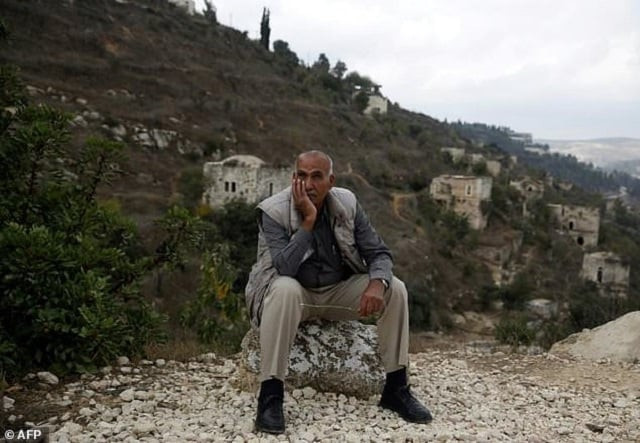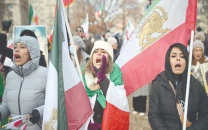Ghost village perched in Jerusalem's hills may soon vanish
It is only around 10 minutes from Jerusalem's Old City

Yacoub Odeh, a 77-year-old Palestinian, sits by old houses in the ghost village of Lifta, whose Palestinian inhabitants fled during fighting in the 1948 war surrounding the creation of Israel
PHOTO: AFP
"I want to come back to my home, to my house, to my village, to my land," the 77-year-old said. Lifta, an abandoned former Palestinian village in a bucolic spot at the entrance to Jerusalem, is at the centre of a preservation fight over an Israeli plan to build villas there.
It is a rare example of a village that still exists after its Palestinian inhabitants fled in the 1948 war surrounding the creation of Israel, though its history extends much farther back in time. The village, in mainly Jewish west Jerusalem, is on a tentative list of UNESCO World Heritage sites, and the World Monuments Fund organisation has put it on its list of sites under threat.
No one lives there anymore, but the remains of stone homes with arched entryways still stand, along with idle olive presses and the ruins of a village mosque. A natural pool in the village's centre continues to be used for swimming during the sweltering Jerusalem summer, while almond, fig and olive trees dot the surrounding hillsides.
For some Palestinians in love, this slum is the only place to live
In the face of plans to develop villas, commercial space and a hotel there, a coalition of Israelis and Palestinians have come together to try to preserve it - sometimes for differing reasons.
Palestinians like Odeh who were chased from their homes in 1948 hope to one day have their land back. Others also want the village to stand as testimony of what happened to Palestinians in 1948 - what they call the Nakba, or catastrophe.
For Israelis involved in the Save Lifta Coalition, including at least one man who lived there after the Palestinians fled, the village must be preserved as a unique, historic site. "It's the most beautiful place in the world," said Yoni Yochanan, a 57-year-old who was among the last to leave a few months ago. Yochanan, who said his parents moved to Lifta in 1951 after arriving from Kurdistan, is not against development, but says the village's history must be kept intact.
Israeli authorities have long sought to develop it, with those in favour saying investment is needed to keep it from deteriorating further. A Jerusalem planning committee in August delayed the plans after concerns were raised over the village's preservation, and a new version is expected.
But plans so far have involved 212 villas with commercial space and a hotel, according to Shmuel Groag, an architect specialising in conservation involved in the Save Lifta Coalition. Zeev Hacohen of Israel's Nature and Parks Authority said any development must respect rules set out by the country's antiquities authority, which has carried out a survey of the site but reportedly delayed its release at the request of Israeli authorities.
A spokeswoman for the Israel Lands Administration said it expects to market the site in the coming months. "A construction plan was drafted which allows for development while paying strict regard to the issue of conservation," Ortal Tzabar said in an emailed response to questions. "To leave the site as it is would lead to neglect and the gradual disintegration of the existing buildings."
Due to the preservation required, the price tag could be especially high for a developer, but the location could still be a draw. It is only around 10 minutes from Jerusalem's Old City yet hidden away, with striking views of surrounding hills.
The coalition says the plan for the villas would essentially destroy the village's rich heritage. Its history is thought to date back to at least the 13th century BC, said Dafna Golan of the Save Lifta Coalition. Some connect it to the biblical Jewish village of Mei Neftoach. It has been built over repeatedly throughout history, and 55 stone homes remain from the Palestinian village that existed before 1948.
"I would say it's frozen evidence of the issue of the destroyed villages," said Groag, the architect involved in preservation efforts. "That's why it annoys the Israeli land authority, because they don't want it turned into a sort of non-official monument for the destroyed villages."
Hamas cedes Gaza border crossings to Palestinian Authority control
Some 750,000 Palestinians - including Lifta's residents - were either forced from their homes or fled during the war surrounding Israel's creation in 1948. Shortly afterwards, Lifta was given a new lease on life when Jews from areas such as Kurdistan and Yemen emigrating to Israel were told to live there by the government, according to Yochanan.
Over the years, they relocated, and the last 13 families received compensation and moved elsewhere in recent months as Israel sought to widen a nearby highway. On a recent day in the village, Odeh, the Palestinian whose family fled, pointed out old stone ovens and said he remembered his mother using them to bake bread.
He followed a trail leading from where he said his family's home was located through the stone ruins. A bridge for a future high-speed train stood in the distance.
"I'm happy to come and see my home... to smell the land," he said. "But at the same time, I am sad that I can't remain here."



















COMMENTS
Comments are moderated and generally will be posted if they are on-topic and not abusive.
For more information, please see our Comments FAQ